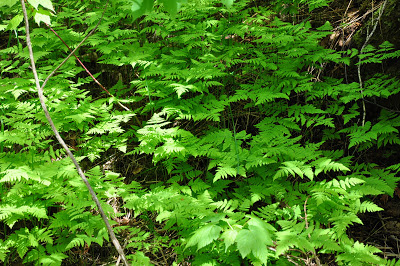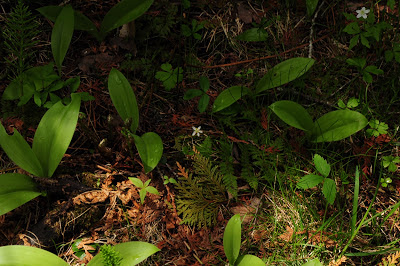Saturday morning it was chilly, foggy and damp, but we weren't about to let a little fog dampen our spirits. By 7:00 AM we were on the road to our first birding hotspot. We cruised up Route 123 and turned off on a dirt (sand) road that goes way back into the forest. This patch was struck by lightning a few years ago, so we were looking for black-backed woodpeckers, who apparently flock to newly-burned woods where they can easily flick the charred bark off the dead and dying trees and access the yummy insects and larvae underneath.

The sides of the road were thickly lined with the pale silvery-green leaves of young big-tooth aspen.
We didn't see any black-backs, but we did see a few (million) mosquitoes. See those brown blurs? Those are them!
The only defense was layers. Layers of clothing, layers of bug net, and layers of bug spray. The day was starting to warm up, and the humidity kept climbing, but despite this, we kept our layers on, and for many that also meant winter gloves!
I've mentioned before I'm not much of a birder (I struggle to tell calls apart, especially sparrows and warblers), so although I was excited to hear a bittern galumping in a distant bog, and am now able to say I've heard a sedge wren thanks to the ears of fellow tripper Don, I was more inclined to look down and say "Ooo - the blueberries are blooming!"
But those of you who really know me, know that THIS was exciting. Scat. Now, back in the 'dacks I'd've been comfortable declaring that this was coyote scat, but we don't have eastern coyotes here in Michigan. The MI coyote is the western coyote (as far as I've been able to ascertain so far), which is smaller. Whose poo is this, then? Wolf!!! Why, that's almost as good as getting a moose!
If it weren't for the mosquitoes, this would've been a lovely place to linger and explore, which we did for an hour or more, but the lure of birds called us elsewhere.
This fungus, creeping out from under the bark, reminded me of spray foam insulation, which puffs and grows out of the space where you squirted it.
One of the few bits of color on this foggy morning landscape was the brilliant pink of this laurel. Over the course of the weekend we saw thousands of these plants in bloom - sometimes blanketing whole wetlands. It's pale laurel, a member of the rhododendron family. But I wasn't convinced it wasn't sheep laurel, for it looked like what was identified as sheep laurel back at the VIC. We finally measured the flowers and looked at leaf growth to determine that indeed it was pale and not sheep.
Back on the road once more, we cruised to our second stop. Along the way we passed marsh marigold in bloom along the road.
If anyone would like to purchase a general store and gas station that is located in the middle of nowhere, I know where one is for sale!
Stop number two was at another burn; this one was last year and was also the result of a lightning strike.
Little Perch Lake, where there were rumors of more black-backed woodpeckers.
A small shrub with white flowers caught my eye. Fire cherry (aka pin or bird cherry), true to its name, grows well in recently burned areas.
The birders, however, were focused on the black-backs, so I hurried to catch up.
As luck would have it, there was a pair of black-backs across the lake. Most of our group got a look at them, and we all heard them. I'd seen black-backs in Newcomb - whacking away at the utility poles in our neighborhood, so this bird was not a novelty to me, but it was still nice to learn a bit more about their biology and behaviors.
Small white violets were growing at the water's edge. Some were actually in the water. Looking closely at the leaves, I'm fairly sure these are lance-leaved violets, which do like to have their toes wet.
Hard by the violets were patches of red (see it above?) - sundews! BUT! These aren't my old friend the spatulate-leaved sundew, these are round-leaved sundews.
It looks like this one had a snack.
And here are all the happy birders: Lathe, Bill, Libby, Joyce, Robin, Don, Gary, Paul and Mickey.
After bagging the black-backs, we hit the road once more.
The sandy slopes along the side of the road turned out to be ideal kingfisher nesting spots! I saw several kingfisher nests in Newcomb back in the day, so these didn't surprise me. What does surprise me is just the fact that these birds dig tunnels into sandy embankments and build their nests at the end! Just doesn't seem like a bird-like thing to do.
Our next destination was the lower Taquamenon Falls. The birders were here for assorted warblers, but it was a touristy stop for me. Taquamenon Falls are the second-biggest falls east of the Mississippi...they come after Niagara. The lower falls are not tall - maybe having a 10 foot drop at the highest spot. But there is a lot of water coming over them.
This lovely map shows the shape of the river and where the falls and trails are located.
After we ooo-ed and ahh-ed over the rush of tannin-filled water, we headed down the nature trail, which is almost entirely boardwalk, and very nicely done. We immediately encountered mountain maple, which I haven't seen since my dendrology class in 1985.
And the ferns! Lots of ferns and here we were without a single fern guide among us! Many looked familiar, and I was there saying things like "that might be a wood fern...maybe that's lady's fern...are those ostrich ferns?" but never quite knowing which ones were which. The only ones we were confident identifying were the bracken and sensitive ferns.
The ones you see below were small - so we knew they weren't brackens. They reminded me of rattlesnake fern, but without the rattle. Looking at my fern ID materials now, and having to go strictly by photographs, I'm wondering if these might be oak ferns, which like moist, acidic soils. The habitat is right, and the description of the small yellow-green leaflets looking like "baby bracken ferns" fits.
Now this one has a fertile frond in the middle, so that should be diagnostic. I'm leaning toward this being ostrich fern.
Marsh marigolds were glowing brilliantly in a large patch on the forest floor.
And I saw my old friend speckled alder! This was ubiquitous in the 'dacks, and I haven't seen it once since moving to Michigan. It was like picking out the face of a long-lost friend from a crowd.
We were all delighted to find a few nodding trilliums! Why nodding and not drooping? Apparently it's the pink anthers that are an important clue.
A little contemplation is good for the soul.
Wood anemones grew in sparse clusters as we continued downhill toward the falls.
And we saw one lone goldthread flower. I looked at it and said to myself "Self...you know this flower!" but for the life of my I couldn't remember what it was. I had to key it out and then felt awfully sheepish that I had forgotten its name. Still, it was new for many of the folks on this trip. The next day we saw quite a few of these and I dug one up to show them the golden yellow roots and explained why the plants were now protected (over-harvested, once-upon-a-time, for cold remedies).
Yesterday I wrote about how many of the plants we saw this weekend were larger than I had ever seen them before. This was the exception. The Jack-in-the-pulpits here were the tiniest I've ever seen. How tiny? These are about the size of cocktail weiners! And every single one we saw here (and there were easily over a hundred) were this small. Hm.
Soon we were at the bottom of the boardwalk and approaching the falls.
In the Adirondacks it's the hemlocks that are a major contributor to the tannin content of the water, but here the oaks are given all the credit for the brown-stained liquid.
At the base of this fall, nestled in an eddy by the rocks, was a sea lamprey cage.
Lucky us! We were there at the right time, for two of the park staff came down to get a few sea lampreys for an exhibit.
These parasitic primitive "fish" are not native to the waters here and are considered a serious concern in fisheries. They are being trapped here by the US Fish and Wildlife Service who are monitoring their numbers. Right now the lampreys are swimming upstream to spawn.
These few were destined for a tank. Some would go back to the trap, others, however, would be "dispatched" after their stint as interpretive props.
So...what does a sea lamprey look like up close? I had the fellow hold one up - but it was only briefly because it was very slippery and the thing was wiggling like mad.
Meanwhile, back at the falls, the rocks below the boardwalk had their own story to tell. See those ripples across the rock? They are ancient - formed by waves millions of years ago.
(Click on photo below to enlarge and read.)
Soon we were headed back up the trail. I was excited to see American fly honeysuckle...especially since I so grossly misidentified something else as this earlier this spring! But this time we have the real thing.
And just in case seeing that lamprey above wasn't enough for you, here it is in the tank back at the top of the walk. That there is the mouth pressed against the glass, and the yellow bit in the very center is the cutting edge of the tongue - that's the part that does the real damage to fish. The holes in the sides of the neck are the primitive gills, and yes, the creature is essentially panting. It is under a bit of stress, what with being captured and handled and stuck in a tank. Does it know it's future is limited?
Stay tuned for Part 3 - the rest of Day 2 in the UP.














































No comments:
Post a Comment